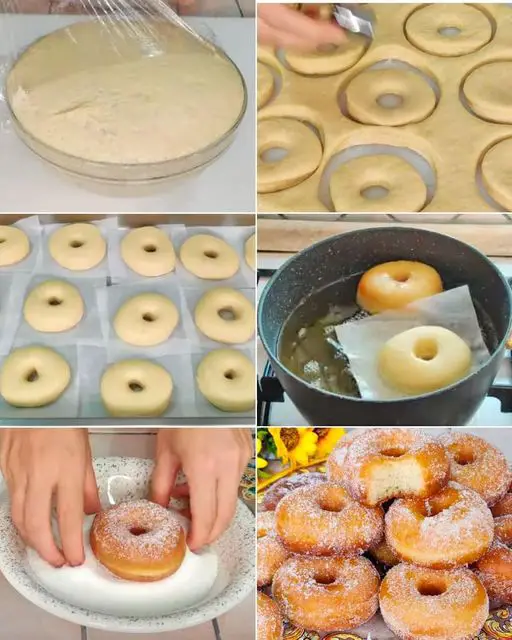In a world where instant gratification is often the norm, taking the time to create something from scratch brings a unique sense of satisfaction and pride. Among the many delights that can be conjured up in the kitchen, homemade doughnuts hold a special place. These circular confections, often associated with comfort, celebration, and pure joy, offer a canvas for culinary creativity that few other sweets can match.
A Brief History of Doughnuts
The doughnut, or donut as it’s alternatively spelled, has a disputed history, with various forms of fried dough appearing in cuisines around the globe. From the Dutch settlers who brought over olykoeks (“oily cakes”) to America, to the purported invention of the ring-shaped doughnut by Hanson Gregory in 1847, the evolution of the doughnut is a fascinating journey through time and culture. Today, doughnuts are a global phenomenon, celebrated in their myriad forms, from the jelly-filled sufganiyot of Israel to the sugar-dusted beignets of France.
The Magic of Making Doughnuts at Home
There’s something almost magical about the process of making doughnuts at home. It starts with the simplest of ingredients—flour, sugar, milk, and yeast—transformed through the alchemy of kitchen science into something that transcends their humble beginnings. This recipe for Milk Brioche Doughnuts takes you through this magical transformation step by step, promising results that are as rewarding to make as they are to devour.
The Ingredients: Foundations of Flavor
Each ingredient in a doughnut recipe plays a pivotal role in the final product’s texture and taste. The choice of milk enriches the dough, lending it a tenderness and flavor that water alone could never achieve. The butter, sugar, and egg work in harmony to create a dough that’s rich yet light, sweet but not overpowering. The yeast, meanwhile, is the silent workhorse, driving the rise and airy texture that are hallmarks of a great doughnut.
The Process: A Labor of Love
Making doughnuts is a labor of love. From activating the yeast to kneading the dough, each step requires patience and care. The first rise is a testament to the power of time, as the dough doubles in size, filled with the promise of soft, fluffy doughnuts. The act of shaping the doughnuts, whether by hand or with cutters, is a moment of creativity, a chance to imprint a part of yourself into each piece. The second rise, then the sizzle of dough hitting hot oil, marks the final transformation, turning pale dough into golden, tempting treats.
Frying vs. Baking: A Textural Dilemma
While this recipe calls for frying, the traditional method for making doughnuts, there’s an ongoing debate about frying versus baking. Frying gives doughnuts their characteristic crispy exterior and soft interior, a textural contrast that’s hard to achieve with baking. However, baking offers a healthier alternative, producing doughnuts that are softer and lighter but lack the classic fried texture. The choice ultimately depends on personal preference and health considerations.
Glazing and Topping: The Final Flourish
The final step in making doughnuts—glazing and topping—offers endless possibilities for customization. A simple sugar glaze, rich chocolate, or tangy lemon icing can transform the flavor profile of your doughnuts. Toppings like sprinkles, nuts, or coconut add texture and visual appeal, making each doughnut a small work of art.
Sharing the Joy: Doughnuts as a Universal Language of Love
Homemade doughnuts are more than just a treat; they’re a gesture of love and generosity. Sharing them with family and friends is a joyous occasion, a way to connect and celebrate over something made with your own hands. Whether it’s a lazy Sunday morning or a special celebration, doughnuts have a way of making any moment sweeter.
FAQs: Homemade Doughnuts
Can I use all-purpose flour instead of bread flour for doughnuts? Yes, you can use all-purpose flour for making doughnuts. While bread flour has a higher protein content that contributes to a chewier texture, all-purpose flour is perfectly fine and will result in a softer, tender doughnut.
What can I do if I don’t have a doughnut cutter? If you don’t have a doughnut cutter, you can use two round cutters of different sizes or even improvise with household items. A large glass or cup can serve as the outer cutter, and a small bottle cap can cut out the doughnut hole.
How do I ensure my doughnuts are fluffy and not oily? To ensure fluffy doughnuts, make sure your oil is at the correct temperature (around 375°F or 190°C) before frying. If the oil is too cold, doughnuts will absorb too much oil and become greasy. If it’s too hot, they’ll brown too quickly on the outside without cooking through. Using a cooking thermometer can help maintain the right temperature.
Can I make the dough ahead of time? Yes, you can prepare the doughnut dough ahead of time. After kneading, place it in a greased bowl, cover, and refrigerate overnight. Allow the dough to come back to room temperature and proceed with the shaping and second rise before frying.
Why did my doughnuts turn out hard? Doughnuts can turn out hard if they’re over-kneaded or fried for too long. Over-kneading develops the gluten too much, making the dough tough, while over-frying can cause them to become crispy rather than soft. Keep a close eye on the frying time and gently knead the dough to avoid overworking it.
Can these doughnuts be baked instead of fried? Yes, for a healthier alternative, you can bake these doughnuts. Place the shaped dough on a baking sheet, let them rise as directed, and then bake in a preheated oven at 350°F (175°C) for about 10-15 minutes or until they’re lightly golden. Note that baked doughnuts will have a different texture compared to fried ones.
How should I store leftover doughnuts? Leftover doughnuts are best enjoyed fresh but can be stored in an airtight container at room temperature for up to 2 days. For longer storage, you can freeze them for up to 2 months. Reheat gently in the oven or microwave before serving.
Can I fill these doughnuts with jam or cream? Absolutely! To fill the doughnuts, use a piping bag fitted with a narrow nozzle. Insert the nozzle into the side of the doughnut and gently squeeze in your filling of choice, such as jam, custard, or whipped cream, until the doughnut feels slightly heavier.
Conclusion: The Timeless Appeal of Homemade Doughnuts
In the end, the appeal of homemade doughnuts lies in their ability to bring together the simple and the sublime, the everyday and the extraordinary. They remind us that taking the time to create something beautiful and delicious is not just about the end product but about the journey itself. So, the next time you’re looking for a way to add a little sweetness to your life, consider reaching for this Milk Brioche Doughnut recipe. It’s a journey well worth taking.
Print
Classic Homemade Doughnuts Recipe
Description
Dive into the world of homemade treats with this classic doughnut recipe. These doughnuts are fluffy, sweet, and irresistibly delicious, perfect for satisfying your sweet tooth any time of the day. Whether you’re a seasoned baker or new to the kitchen, this recipe is straightforward, promising delightful results that are sure to impress family and friends. Here’s how to make these heavenly pastries from scratch.
Ingredients
- 3 cups of flour: The base of your dough, providing structure.
- 2 tablespoons of butter: Adds richness and flavor to the dough.
- 7 grams of baker’s yeast: The key leavening agent that helps the dough rise, creating light and airy doughnuts.
- 5 tablespoons of sugar: Sweetens the dough to perfection.
- 1 cup of milk: Moistens the dough and activates the yeast. Make sure it’s lukewarm to help the yeast thrive.
- 1 egg: Binds the ingredients together and contributes to the dough’s richness.
- ½ teaspoon of salt: Enhances the flavors of the other ingredients.
Instructions
Prepare the Yeast Mixture:
- In a small bowl, dissolve the baker’s yeast in a quarter cup of lukewarm milk. Add a teaspoon of sugar (from the 5 tablespoons) to help activate the yeast. Let it sit for about 5-10 minutes, or until frothy.
Mix the Dough:
- In a large mixing bowl, combine the flour, remaining sugar, and salt. Mix well.
- Make a well in the center and add the activated yeast mixture, the rest of the milk, the egg, and softened butter. Mix everything together until a soft dough forms.
Knead the Dough:
- Transfer the dough to a floured surface and knead for about 8-10 minutes, or until smooth and elastic.
- Place the kneaded dough back into a greased bowl, cover with a clean kitchen towel, and let it rise in a warm place for about 1 hour, or until it doubles in size.
Shape the Doughnuts:
- Once risen, punch down the dough to release any air bubbles.
- Roll out the dough on a floured surface to about ½ inch thickness. Use a doughnut cutter (or two differently sized round cutters) to cut out doughnut shapes.
- Place the cut doughnuts on a baking sheet, cover lightly, and let them rise again for about 30 minutes.
Fry the Doughnuts:
- Heat oil in a deep fryer or a large, deep pan to 375°F (190°C). Carefully place a few doughnuts at a time into the hot oil, frying each side until golden brown, about 1 minute per side.
- Remove the doughnuts with a slotted spoon and drain on paper towels.
Finish with a Glaze or Topping:
- For a simple glaze, mix powdered sugar with a little milk or water until you achieve a runny consistency. Dip each doughnut into the glaze, letting the excess drip off, or roll them in granulated sugar or cinnamon sugar for a different finish.
Notes
Serving Suggestions:
Enjoy your homemade doughnuts fresh and warm for the best experience. They’re perfect as a decadent breakfast treat, a sweet snack, or a dessert to cap off any meal. Pair them with your favorite coffee or tea for a match made in heaven.
Conclusion:
Making doughnuts at home is a rewarding experience that brings a touch of bakery-style indulgence to your kitchen. With this classic recipe, you’re not just baking; you’re creating moments of joy to share. So, the next time you’re in the mood for something sweet, whip up a batch of these fluffy, delicious doughnuts and watch them disappear in no time.

